Plants to make a porch smell nice are more than just beautiful additions to your outdoor space; they transform it into a fragrant oasis. The right scents can evoke feelings of relaxation, joy, or even a sense of nostalgia, creating a welcoming atmosphere that draws you outdoors.
Imagine stepping onto your porch and being greeted by the sweet aroma of lavender, the refreshing scent of rosemary, or the delicate fragrance of jasmine. These scents, along with the visual appeal of the plants themselves, can enhance your porch experience and make it a truly special place to unwind and enjoy the outdoors.
This guide explores the world of fragrant plants, providing insights on choosing the right plants for your porch, caring for them, and designing a fragrant garden that delights your senses. We’ll delve into different plant varieties, their scents, and how to create a fragrant haven that reflects your personal style and preferences.
Fragrant Plants on Your Porch: Enhancing Your Outdoor Experience
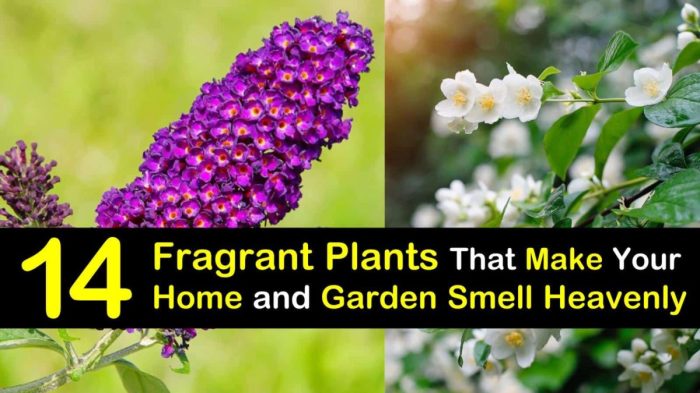
Transforming your porch into a fragrant oasis can enhance your outdoor experience, inviting you to relax and enjoy the fresh air. The right plants, with their captivating scents, can create a welcoming atmosphere and elevate your porch’s ambiance.
The Power of Scent
The power of scent is undeniable. Our sense of smell plays a significant role in shaping our emotions and memories. Aromatherapy, the practice of using essential oils for therapeutic purposes, highlights the connection between scent and well-being. The scents of plants on your porch can evoke feelings of calm, joy, and even nostalgia.
Fragrant Plants for Full Sun: Plants To Make A Porch Smell Nice
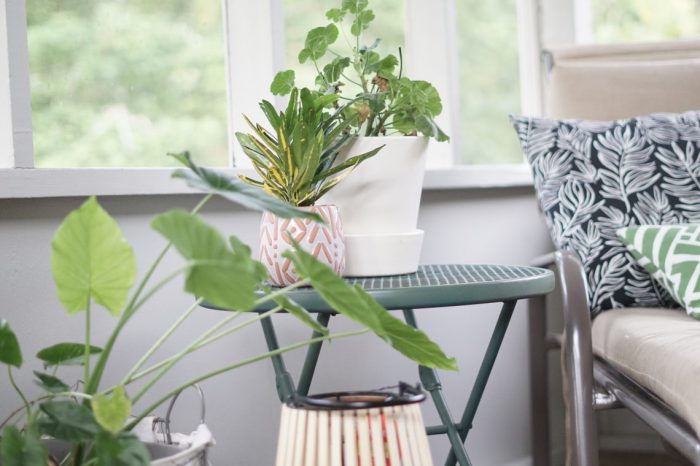
Basking in the sun’s warmth, your porch can transform into a fragrant haven with the right selection of plants. These sun-loving species not only add visual appeal but also infuse the air with captivating aromas, creating a welcoming and sensory-rich outdoor experience.
Fragrant Plants for Full Sun
Full sun, defined as six or more hours of direct sunlight daily, provides the ideal conditions for many fragrant plants to thrive. These plants not only tolerate the heat but also require it to produce their most potent scents. Here’s a table outlining some popular choices:
| Plant Name | Scent Description | Bloom Time | Special Considerations |
|---|---|---|---|
| Lavender (Lavandula angustifolia) | Sweet, floral, and calming | Late spring to early summer | Prefers well-drained soil and can tolerate some drought |
| Rosemary (Rosmarinus officinalis) | Herbaceous, slightly piney, and medicinal | Spring to early summer | Requires well-drained soil and can tolerate some drought |
| Lemon Verbena (Aloysia citriodora) | Citrusy, lemony, and refreshing | Summer | Prefers well-drained soil and may need winter protection in colder climates |
| Pineapple Sage (Salvia elegans) | Fruity, sweet, and reminiscent of pineapple | Fall | Attracts hummingbirds and butterflies |
| Sweet Basil (Ocimum basilicum) | Spicy, sweet, and slightly peppery | Summer | Can be grown as an annual in colder climates |
Fragrant Plants for Partial Shade
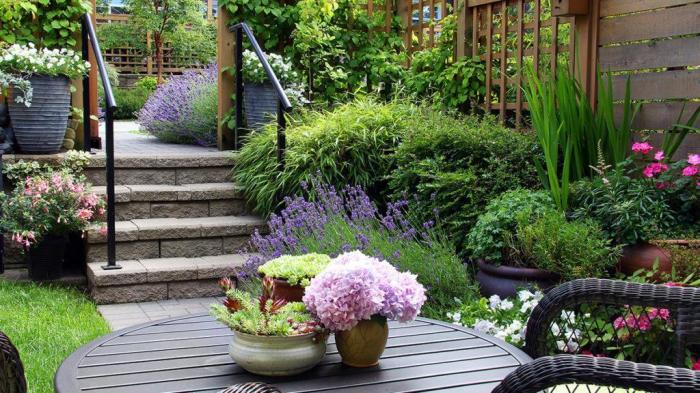
Partial shade offers a haven for a variety of fragrant plants that thrive in dappled sunlight. These plants not only add a burst of color and texture to your porch but also fill the air with delightful scents, creating a truly inviting atmosphere.
Fragrant Plants for Partial Shade
| Plant Name | Scent Description | Bloom Time | Special Considerations |
|---|---|---|---|
| Gardenia | Sweet, rich, and intoxicating, often described as a floral, citrusy, and slightly spicy aroma. | Late spring to early summer | Prefers acidic soil and consistent moisture. |
| Jasmine | Sweet, heady, and intensely floral, often compared to the scent of a tropical paradise. | Summer to early fall | Needs well-drained soil and regular watering, especially during dry periods. |
| Sweet Alyssum | Honey-like, delicate, and slightly sweet, with a touch of citrus. | Spring to fall | Tolerates a wide range of soil conditions and prefers full sun to partial shade. |
| Daphne | Intensely sweet, spicy, and intoxicating, often described as a heady and unforgettable fragrance. | Late winter to early spring | Prefers well-drained soil and a sheltered location. |
These plants are relatively easy to care for in partial shade. They prefer a location that receives at least 4 hours of indirect sunlight per day. Ensure the soil is well-drained and consistently moist, but avoid overwatering. Regular fertilization can promote healthy growth and abundant blooms.
Fragrant plants like jasmine and honeysuckle can make your porch a welcoming oasis, but proper care is essential. To ensure your plants thrive, understanding and preventing leaf scorch is crucial. Leaf scorch, a condition caused by excessive water loss, can be avoided by providing adequate watering and ensuring proper drainage.
Learn more about what is leaf scorch and how to avoid it. Once you’ve mastered the art of keeping your plants healthy, you can enjoy the sweet aroma of your fragrant porch haven.
Fragrant Plants for Containers
Fragrant plants in containers offer a versatile and convenient way to enjoy their alluring scents on your porch. They provide a wonderful opportunity to create a captivating olfactory experience in your outdoor space, adding an extra dimension to your porch’s aesthetic appeal.
Choosing the Right Container
Selecting the appropriate container is crucial for the health and thriving of your fragrant plants. Consider the following factors:
- Size:The container should be large enough to accommodate the plant’s root system and allow for adequate drainage. Overcrowding can lead to stunted growth and poor flowering.
- Material:Terracotta pots are porous, allowing for good drainage and air circulation. Plastic containers are lightweight and affordable, but they can retain moisture, potentially leading to root rot if not properly monitored. Other materials, such as metal, wood, or ceramic, can also be used, but ensure they have drainage holes.
A fragrant porch is a welcoming one, and many plants can contribute to that ambiance. While some like lavender and rosemary are obvious choices, you might also consider adding peonies, which offer a delightful scent. But before you enjoy their blooms next spring, you’ll need to decide if you should peonies be cut back in the fall.
This practice can help prevent disease and promote healthy growth, ensuring your peonies continue to fill your porch with their sweet fragrance for years to come.
- Style:Select a container that complements your porch’s decor and personal taste. There are countless styles and designs available, from traditional terracotta pots to modern planters.
Fragrant Plants Suitable for Containers
Several fragrant plants thrive in containers, adding a delightful aroma to your porch. Here are a few examples:
- Lavender (Lavandula angustifolia): This perennial herb is known for its calming, floral scent. It prefers full sun and well-drained soil. Lavender can be easily propagated from cuttings or seeds. To ensure healthy growth, prune regularly to maintain its shape and encourage new growth.
- Rosemary (Salvia rosmarinus): This aromatic herb offers a strong, pungent scent with notes of pine and camphor. It prefers full sun and well-drained soil. Rosemary can be grown from cuttings or seeds. Regular pruning can promote bushier growth and encourage more fragrant foliage.
- Sweet Alyssum (Lobularia maritima): This annual flower produces small, fragrant white or purple blooms. It prefers full sun and well-drained soil. Sweet Alyssum is a fast-growing plant and can be easily propagated from seeds. It is known for its ability to attract pollinators to your garden.
- Gardenia (Gardenia jasminoides): This flowering shrub produces beautiful, fragrant white blooms. It prefers partial shade and acidic soil. Gardenias require regular watering and fertilization to thrive. They are susceptible to pests and diseases, so regular monitoring is essential.
- Lemon Verbena (Aloysia citriodora): This herb has a strong citrusy scent. It prefers full sun and well-drained soil. Lemon verbena can be propagated from cuttings or seeds. Regular pruning can promote bushier growth and encourage more fragrant foliage.
Tips for Maintaining Fragrant Plants
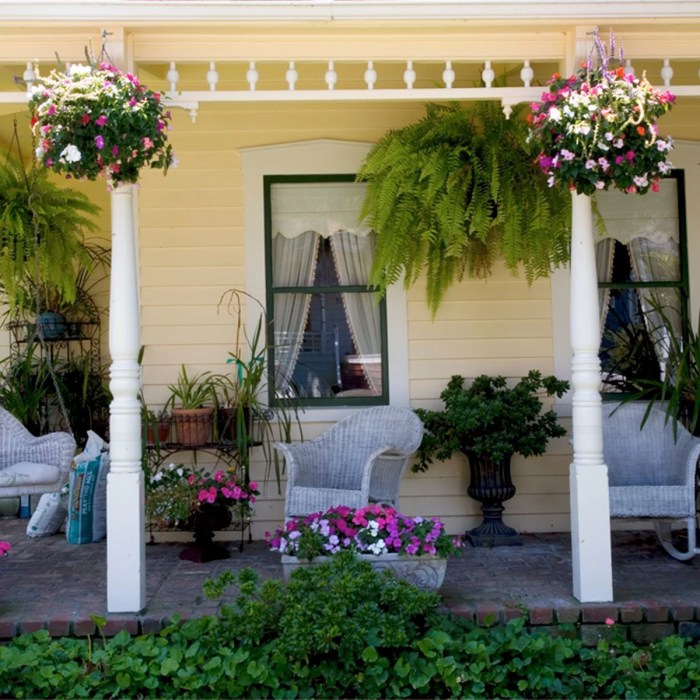
Maintaining fragrant plants is essential for maximizing their beauty and scent. With a few simple techniques, you can ensure your plants thrive and fill your porch with delightful aromas.
Pruning Fragrant Plants, Plants to make a porch smell nice
Pruning fragrant plants is a crucial step in encouraging growth and flowering. Regular pruning helps to maintain the plant’s shape, remove dead or diseased branches, and stimulate new growth.
- Pruning for Shape:Prune fragrant plants after flowering to maintain their desired shape and size. For example, rose bushes can be pruned to promote bushier growth and more flowers.
- Deadheading:Deadheading involves removing spent blooms, which encourages the plant to produce more flowers. This technique is particularly effective for plants like lavender and salvia.
- Thinning:Thinning out overcrowded branches helps to improve air circulation and sunlight penetration, reducing the risk of diseases and pests.
Fertilizing Fragrant Plants
Fertilizing provides fragrant plants with essential nutrients for healthy growth and abundant blooms.
- Types of Fertilizer:Use a balanced fertilizer specifically designed for flowering plants. Organic fertilizers, such as compost or manure, are good options, while synthetic fertilizers can provide a quick boost of nutrients.
- Frequency:Fertilize fragrant plants every 4-6 weeks during the growing season. However, follow the specific instructions on the fertilizer packaging for the best results.
- Application:Apply fertilizer around the base of the plant, avoiding direct contact with the stems and leaves.
Watering Fragrant Plants
Watering is essential for keeping fragrant plants hydrated and thriving.
- Watering Frequency:Water fragrant plants deeply but infrequently, allowing the soil to dry slightly between waterings. Overwatering can lead to root rot and other problems.
- Watering Techniques:Use a watering can or hose to water the base of the plant, avoiding wetting the leaves. Watering in the morning allows the plants to dry before nightfall, reducing the risk of fungal diseases.
- Mulching:Mulching around the base of the plants helps to retain moisture and suppress weeds. Use organic materials like wood chips or shredded bark for effective mulching.
Protecting Fragrant Plants from Pests and Diseases
Protecting fragrant plants from pests and diseases is essential for their health and longevity.
- Regular Inspection:Inspect plants regularly for signs of pests or diseases, such as insects, discoloration, or wilting. Early detection is crucial for effective treatment.
- Pest Control:Use natural pest control methods like insecticidal soap or neem oil for common pests. Avoid using harsh chemicals that can harm beneficial insects and pollinators.
- Disease Prevention:Proper watering, pruning, and good air circulation help to prevent fungal diseases. If diseases do occur, remove affected parts and dispose of them properly to prevent spreading.
Concluding Remarks
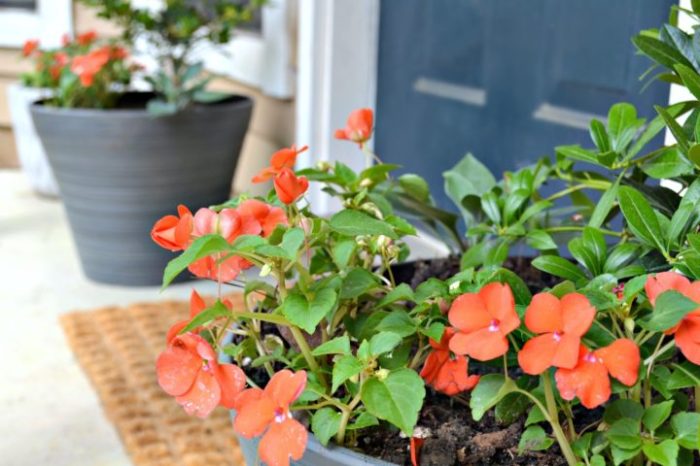
Transforming your porch into a fragrant paradise is an enriching experience that combines the beauty of nature with the power of scent. By selecting the right fragrant plants, understanding their care needs, and arranging them strategically, you can create a welcoming and aromatic outdoor space that invites you to relax, unwind, and enjoy the simple pleasures of life.
With a little planning and effort, your porch can become a sanctuary of scent, offering a delightful escape from the everyday hustle and bustle.